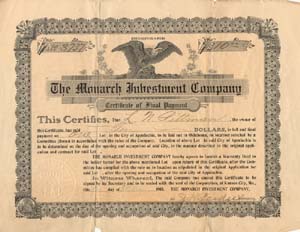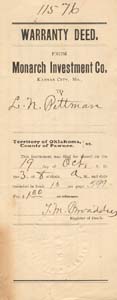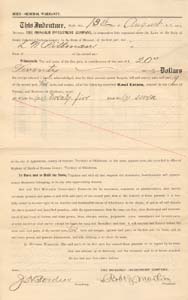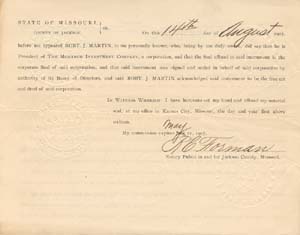![]()
APPALACHIA - A GHOST TOWN
If "Mr. Ghost came to Town" to hunt or haunt the former location of
Appalachia he would find only a raised strip of broken concrete walk
and a few shattered descending steps along the highway. This walk
and others like it were once merry promenades in front of the
rollicking saloons in the thirsty pre-statehood days.
Keystone, nineteen miles west of Tulsa, at the intersection of
national Highway 64 and state highway number one, had been settled
in 1893 rather sparsely but enough to give the Monarch Investment
Company of Kansas City an idea. Why not a new town, boom town on the
Oklahoma Territory side to satisfy the thirst of the growing
population across in the Indian Territory where traffic in liquor
was taboo?
So in 1903 the Monarch Investment Company bought two farms near the
junction of the Cimarron and Arkansas rivers and converted them into
town lots (they paid at the rate of $6000.00 per quarter section),
and peddled them out at $20.00 per lot--or tried to. "Possibly
twenty lots were sold," Sherman ACKLEY said.
A great barbecue was held. Gaudily dressed salesmen mingled with the
merrymakers. But luck was not so good. Homes at the best were not
much more than shacks, and most frequently tents. Not so the
saloons. Soon there were seven of them flourishing. Some rather
makeshift; some only in tents. So Appalachia was born. A name given
in honor of the hills surrounding the district which reminded some
of the old timers of their native eastern mountains. Since it was in
Oklahoma Territory, its saloons could flourish. While a few hundred
feet east and south of the new city was Indian Territory, where
prohibition ruled. So when the thirsty throng heard of saloons so
near at hand, they greeted the news with a stampede to Appalachia.
Some came on horseback. Others jolted overland in wagons. The more
prosperous arrived in buckboards drawn by spirited teams. The roads
of the territory at that time were nothing more than trails.
Long wagon trains hauled supplies for the saloons from Pawnee, fifty
miles away, but the nearest point on a railroad. More than a day and
a half were required to make the trip of fifty miles.
With business booming, Appalachia confidently constructed a swinging
bridge across the Cimarron--two cables stretched across then boarded
for a foothold. Most of the men from the Indian Territory came from
the south. Red Fork and Sapulpa, leading cities of the district,
supplied most of the business. Parking their horses, buckboards and
wagons on the south side of the Cimarron, the riders had a dizzy
journey across the shaky bridge and oftener a dizzier journey back,
if the cold waters of the river could tell the tale.
The most prosperous saloon on the Appalachia side was owned by Lee
McAFEE, formerly a sheriff in Paris, Texas. Then came Joe WIERMAN, a
deputy U.S. Marshal, on the scene to keep law and order in
Appalachia. He looked the situation over and decided to open a
saloon. Since most of the business came from south of the river he
decided it would be wise to locate on that side and thus eliminate
the risky trip across the swinging bridge.
(INTERVIEW: February, 25, 1937 with
Sherman ACKLEY)
From OKGENWEB
http://okgenweb.org/pioneer/ohs/ackley-sherman.htm
Oklahoma
Federation of Labor Collection, Western History
Collections,
University of Oklahoma, Norman, Oklahoma
Lewis Newton Pittman bought two lots in Appalachia for himself and
his father.
Here are the original certificates of sale and
deed to lots in the city of
Appalachia, Oklahoma
Click on documents to enlarge
 |
 |
 |
 |
 |
|